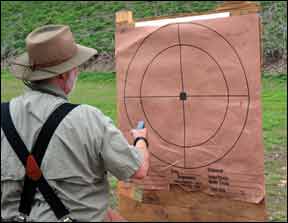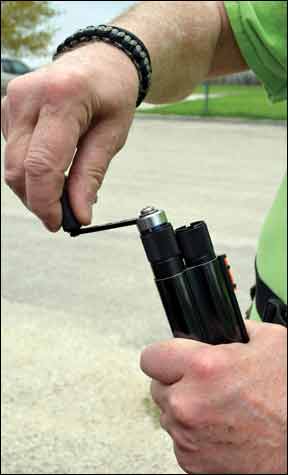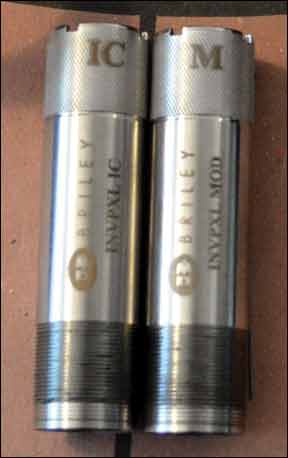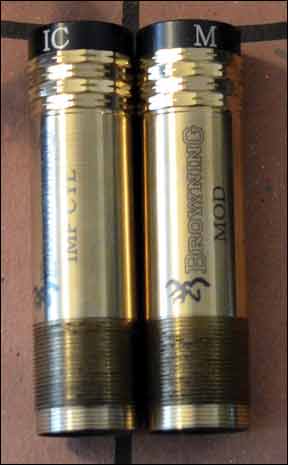Interchangeable choke tubes have been a feature for smokepole enthusiasts since Winchester Firearms created the system in 1959. The first experiment ended in 1965 because of functioning problems, but the Winchoke system introduced in 1970 took hold and is considered the grandfather of choke development. Today, it is hard to find a shotgun that does not feature some kind of interchangeable choke system.
Perhaps a little trip back to the physics classroom is necessary at this time. For those who still remember the days of Shotgun Chokes and Ballistics 101, we request a little indulgence.

When the powder charge sends the shot column down the barrel, it reaches the choke and is forced to squeeze together before exiting the muzzle. That constriction is called radial force. As the shot column leaves the barrel, gravity and wind resistance immediately take over and attempt to force the pellets inside the column to spin and flare off. The tighter the pellets are squeezed together by radial force inside the choke, the more the pellets hold together over a longer distance and produce a tighter pattern.
Constriction of the chokes is measured in thousandths of an inch and, in general, breaks down to the following measurements that are subtracted from the bore diameter of the barrel: Cylinder, .000; Skeet, .005; Improved Cylinder, .010; Modified, .020; Improved Modified, .030; Full, .040.
For example, in our patterning and handling tests, we selected a Browning Model XS Citori 12-gauge over and under with 32-inch barrels that was reviewed in previous editions of Gun Tests. The interchangeable chokes from the various manufacturers were all designed to fit the Browning. We checked the bore measurement of the XS with a bore gauge and the reading was .740. The constriction of all the choke tubes was subtracted from that figure to determine their bore diameter.
One more part of the classroom review states that in most cases the improvement in the pattern on a target at 30 yards over the widest pellet spread with a cylinder choke is about 10-13 percent with skeet; 15-17 percent with improved cylinder; 25-27 percent with modified; 30-33 percent with improved modified; and about 35 percent with a full choke. Students can now close their books.
It should be noted in reading through our test that performance results will vary depending upon individual shotguns and some shooters make their choke selection based on tube qualities other than patterning, such as ease of use; weight; and even appearance.

All of these individual factors are a matter of personal preference and help drive the quest to find the right combination of choke tube length and constriction that produces the optimum pattern performance. As one smoke-pole veteran said: “Whatever works for you, works for you — Don’t mess with something that works.”
In our test, we examined the results using both an improved cylinder and modified choke. The ammunition used was Winchester AA Xtra-Lite 2.75 inch Target Loads with one ounce of No. 71⁄2 shot and 2.75 dram equivalent of powder producing an average 1180 fps muzzle velocity.
All of the chokes in the test were fired at a 30-inch circle on a paper target placed 30 yards downrange. We noted that there was very little deviation in the overall pattern of pellet strikes on the paper, with all the chokes tending to produce slightly more strikes on the left side of the circle rather than on the right. This result probably is a factor of gun fit for the shooters, rather than choke fit in the barrel.

We also tested all the chokes on clay target presentations on a couple of different sporting clays ranges. While target breaks can vary according to the skills of the shooter more than because of the effectiveness of the chokes, we also used the “feel-good” factor to judge how well the tubes worked on clays in our evaluation.
Briley Extended Choke Tubes, $43
Although slightly on the heavy side compared with the other chokes, the Brileys were easy to install and remove with a choke wrench or by hand. They were clearly identifiable as to their constriction and our measurements proved they were right on the money. On the patterning board, the modified choke produced a 60/40 hit ratio, with most of the pellets striking above the center of the target. The improved cylinder pattern was just slightly less top heavy, coming in at 53/47. The number of hits in the 30-inch circle and with the center 20-inch circle was very acceptable (326 and 245 with the modified choke and 259 and 172 with the improved cylinder). But we did find five target-sized holes in the modified pattern and four in the improved cylinder pattern.
Our Team Said: Holes in the pattern could mean missed targets even when the bird or clay was in the hit zone. In addition, the spread of the hits in the four different quadrants was a little more uneven than we would have liked.
Browning Invector Plus Flush Choke Tubes, $30
These types of tubes have already been replaced with extended chokes in most cases and their performance on the pattern target was a clear indication they are not as good as the newer tube models. Constriction of the modified choke was just .737 of an inch and the improved cylinder choke measured .750 of an inch – more open than the bore of the barrel. The number of hits in the 30-inch circle and the 20-inch circle with the modified choke was 266 and 178 respectively. The improved cylinder choke landed 178 and 96 hits respectively. In both cases the number of hits was less than any of the other chokes in the test. Combined with four target-sized holes with the modified choke and six with the improved cylinder, these chokes received very low marks in performance.
Our Team Said: Markings designating the constriction were a little hard to read and since the chokes fitted flush with the end of the barrel, a choke wrench was required in all cases for removal and installation. That means another tool had to be carried in the shell bag. On the plus side, they are among the least expensive of all the chokes, but like in many cases, the shooter often gets what he pays for.
Browning Diana Grade Extended Choke Tubes, $65

A very impressive performance with the modified choke of 351 hits in the 30-inch circle and 274 hits in the 20-inch circle, with a 51/49 spread, were two plus marks for the Diana Grade chokes. The improved cylinder did not fare as well, with 242 and 153 hits, respectively, and a spread of 31 percent above the center and 69 percent below. There were only two holes in the modified pattern but five potential target-missing spaces in the improved cylinder pattern. Constriction of the chokes was slightly tighter than the standard, with the modified choke measuring .719 of an inch and the improved cylinder measuring .729.
Our Team Said: We did like the looks of the gold and black Diana Grade chokes, and they were easily installed and removed with both a choke tool and by hand. The clay target performance was among the top three of all the tubes tested — another plus for Diana Grade. Target breaks were confidence builders and we liked the way the shotgun moved into the target path with the heavier chokes.
Colonial Arms Extended Choke Tubes, $28.50
These chokes were priced for the budget-minded shooter and proved to be a disappointment from the beginning due to their short length topped with a roughed-out knob used to install and remove the tubes by hand. Markings designating the constriction were hard to read and their measurements were a bit off the normal range. While the patterns with both the modified and improved cylinder chokes were both about 60/40, the number of holes in the 30-inch pattern (five) and in the 20-inch pattern (three) were less than satisfactory. The cost of the chokes, $28.50 each, was the lowest of any of the tubes in the test and once again, performance suffered.
Our Team Said: Target hits with the Colonials were sporadic at best, possibly because of a lack of confidence in the tubes after the patterning performance.
Muller Extended Choke Tubes, $74.95
Among the newest offerings on the market, the Muller chokes lived up to their reputation by exhibiting very good performance on both the patterning range and sporting clays courses. The purely subjective likability of the chokes was reflected on the clay target courses where target breaks seemed to be much more solid. Among the longest and lightest of the test tubes, they measured 3.5 inches long and weighed only .658 ounces (modified) and .580 ounces (improved cylinder). While they could only be installed and removed by hand, their extended length beyond the barrel made the actions quite easy. Patterns with the modified choke were 56/44 with a very impressive 350 hits in a 30-inch circle and very high 293 hits in the 20-inch circle. That could be the reason for a lot of clays turned into puffs of dust on the range. The improved cylinder choke produced a 52/48 pattern with 214 hits in the 30-inch circle and 115 hits in the 20-inch circle. Both chokes only had three holes in their patterns and the spread of hits inside each quadrant was among the most uniform of all the tested tubes.

Our Team Said: It should be noted that the price of the Mullers is the highest of any of the tubes in the test, coming in at $74.95 each. In this case, paying more does mean higher quality performance.
Trulock Extended Choke Tubes, $56
After the smoke had cleared, the Trulock tubes produced the most uniform patterns with the fewest number of holes (only two with the modified choke and only one with the improved cylinder). The spread was good across all quadrants on paper and like the Muller chokes, clays were regularly turned into puffs of dust from very solid hits. The constriction of the tubes was right on target with the standard measurement with a reading of .720 for the modified and .730 for the improved cylinder. On the scales, the weight of the chokes was among the heaviest of the test tubes, coming in at 1.547 of an ounce for the modified and 1.145 of an ounce for the improved cylinder.
Our Team Said: We had no problems removing and installing the Trulock extended tubes with either a choke wrench or by hand. About the only down side was in the number of hits on the pattern targets. There were 299 pellets in the 30-inch circle and 206 hits in the 20-inch circle with the modified choke; and 214 hits in the 30-inch circle and 150 hits in the 20-inch circle with the improved cylinder. Not the best performance, but certainly not the worst. The Trulock tubes also ranked high with the “feel-good” factor and instilled confidence on the sporting clays ranges.
Browning Invector DS Extended Choke Tubes, $48.49

These new chokes on the market only fit the new Browning Model 725 Citori over and under or the re-introduced Browning Model A-5 semiautomatic and are being advertised as cleaner and better performing than other tubes on the market. Since we had a Model 725 in our hands for another Gun Tests review, we added the new Invector DS chokes as a side test to our choke review. The chokes are long, measuring 4 inches in length, but come in weighing only 1.325 ounces in modified and 1.275 ounces in improved cylinder. They feature a brass ring — the double seal — near the bottom of the choke that is designed to help keep the chokes cleaner when the shotgun is fired. We found that the modified choke produced a 60/40 pattern and the improved cylinder produced a 50/50 pattern. Hits were a very impressive 306 in the 30-inch circle with the modified choke and 213 in the 20-circle. Similar results were produced with the improved cylinder choke, with 280 hits in 30 inches and 200 hits in 20 inches.
Our Team Said: While the patterns were very uniform across all the quadrants, we found three holes with the modified choke and four holes with the improved cylinder. That could have been a factor in the clay target performance, which was not as impressive as either the Muller or Trulock chokes.
Because the chokes could not be used in the same shotgun as the other tubes, we did not grade the Invector DS chokes and have provided the patterning results as merely additional information for our readers’ review.


























